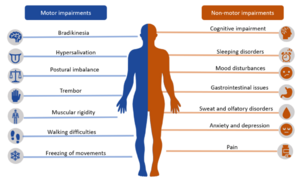Biomarkers of Parkinson's Disease: Difference between revisions
No edit summary |
No edit summary |
||
| Line 31: | Line 31: | ||
=== 2. Biochemical biomarkers === | === 2. Biochemical biomarkers === | ||
==== Bodily fluids and tissue-based ==== | |||
==== Genetic ==== | |||
=== 3. Neuroimaging biomarkers === | === 3. Neuroimaging biomarkers === | ||
Revision as of 05:40, 20 May 2022
Original Editor - Arnold Fredrick D'Souza
Top Contributors - Arnold Fredrick D'Souza, Libby McConnell, Kim Jackson and Lucinda hampton
This article or area is currently under construction and may only be partially complete. Please come back soon to see the finished work! (20/05/2022)
An introduction to Biomarkers[edit | edit source]
The Biomarkers Definitions Working Group defines biomarkers (biological markers) as ‘‘a measurable indicator of some biological state or condition that is objectively measured and evaluated to examine normal biological processes, pathogenic processes, or pharmacologic responses to a therapeutic intervention.’’ Biomarkers could be a used as a diagnostic tool, disease staging tool, prognostic tool, or for predicting and monitoring the clinical response to an intervention.[1] Biomarkers can have molecular, histological, radiographical, or physiological characteristics.[2]
Biomarkers and Parkinson's disease[edit | edit source]
Based on their characteristics, biomarkers of Parkinson's disease (PD) can be classified into 8 major categories[3]:
- Clinical
- Biochemical
- Neuroimaging
1. Clinical biomarkers[edit | edit source]
Motor features of PD[edit | edit source]
These include cardinal signs of PD which are resting tremors, bradykinesia or akinesia, rigidity (of lead-pipe or cogwheel variety), and postural instability.[4]
Non-motor features of PD[edit | edit source]
These include idiopathic rapid eye movement (REM) behavior disorder [characterized by the loss of atonia in REM sleep], hyposmia or anosmia (impaired very early during the course of the disease; also it is important to note that despite not being specific to PD, it is relatively uncommon in those with secondary Parkinsonism), and constipation (again being non-specific to PD in isolation, but its presence in combination with loss of olfaction and neuroimaging can allow for a more informed diagnosis of PD).[4]
All the above can be identified/quantified using clinical rating scales such as Hoehn and Yahr scale (H&Y), Unified Parkinson's Disease Rating Scale (UPDRS), Non-Motor Symptoms Scale for Parkinson's Disease (NMSS), and The Parkinson's Disease Questionnaire (PDQ-39) among many others.[4]
2. Biochemical biomarkers[edit | edit source]
Bodily fluids and tissue-based[edit | edit source]
Genetic[edit | edit source]
3. Neuroimaging biomarkers[edit | edit source]
Application in physiotherapy research[edit | edit source]
Oral biomarkers of exercise-induced neuroplasticity in Parkinson's disease[edit | edit source]
Abnormal expressions of the alpha-synuclein protein, characteristically seen in the brain stem of persons with PD, can also be detected in saliva. The sympathetic and parasympathetic innervation of the sub-mandibular glands are said to be responsible for this transduction via the central nervous system. Alpha-synucleiopathies are directly linked with the progression of PD.[5]
The following biomarkers have been found to increase in response to exercise[5]:
- Brain Derived Neurotrophic Factor (BDNF)
- Catalase (CAT)
- Dopamine Receptor D2 (DRD2)
- Glial Cell Line-Derived Neurotrophic Factor (GDNF)
- Glial Fibrillary Acidic Protein (GFAP)
- Glutamate Ionotropic Receptor AMPA type subunit 2 (GRIA2)
- Nitric Oxide Synthase 2 (NOS2)
- Super Oxide Dismutase (SOD1)
- Vascular Endothelial Growth Factor A (VEGFA)
References[edit | edit source]
- ↑ Biomarkers Definitions Working Group. Biomarkers and surrogate endpoints: preferred definitions and conceptual framework. Clin Pharmacol Ther. 2001 Mar;69(3):89-95.
- ↑ FDA-NIH Biomarker Working Group. BEST (Biomarkers, EndpointS, and other Tools) Resource [Internet]. Silver Spring (MD): Food and Drug Administration (US); 2016 Jan 28 [Updated 2021 Nov 29].
- ↑ Sharma S, Moon CS, Khogali A, Haidous A, Chabenne A, Ojo C, Jelebinkov M, Kurdi Y, Ebadi M. Biomarkers in Parkinson's disease (recent update). Neurochem Int. 2013 Sep;63(3):201-29.
- ↑ 4.0 4.1 4.2 Morgan JC, Mehta SH, Sethi KD. Biomarkers in Parkinson's disease. Curr Neurol Neurosci Rep. 2010 Nov;10(6):423-30.
- ↑ 5.0 5.1 Mougeot JL, Hirsch MA, Stevens CB, Mougeot F. Oral biomarkers in exercise-induced neuroplasticity in Parkinson's disease. Oral Dis. 2016 Nov;22(8):745-53.








